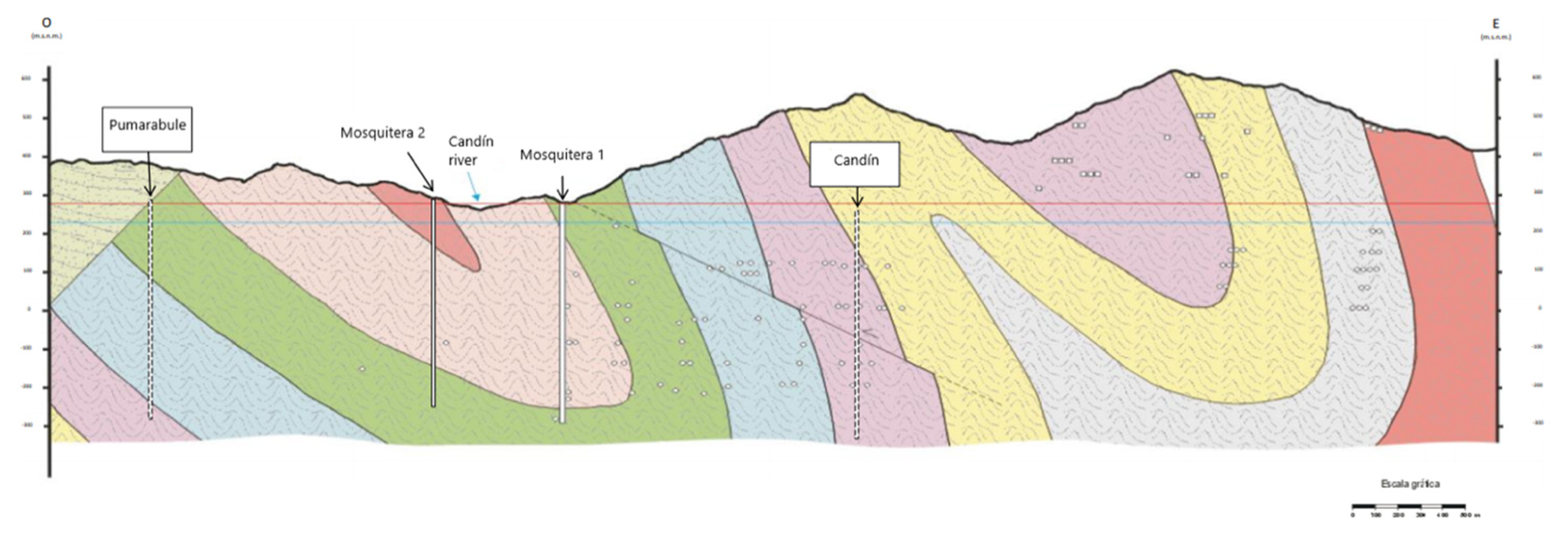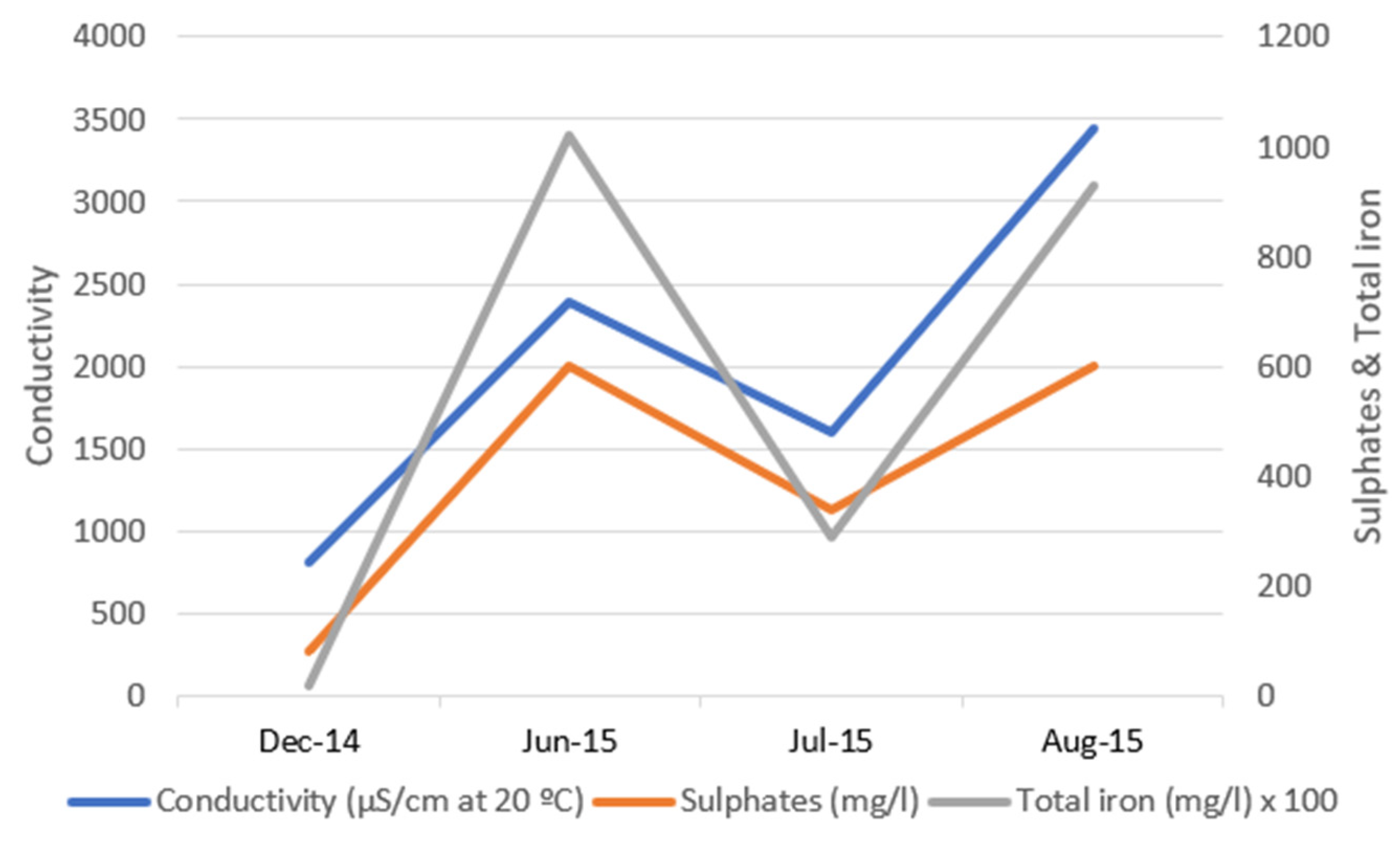Groundwater Risk Assessment in the Context of an Underground Coal Mine Closure and an Economic Evaluation of Proposed Treatments: A Case Study
Abstract
1. Introduction
2. Materials and Methods
2.1. Pumarabule and Mosquitera Mines
2.2. Risk Management Process
2.2.1. Establishing the Context: Risk Criteria
- The pH should be situated between 6.3 and 8.6;
- Suspended solids should be equal or lower than 32.7 mg/L;
- Conductivity at 20 °C should be lower than 2814 µS/cm;
- Total iron should be lower than 10 mg/L;
- Sulphates should be lower than 500 mg/L.
2.2.2. Risk Identification
2.2.3. Risk Analysis
2.2.4. Risk Evaluation
2.2.5. Risk Treatment
3. Results
3.1. Risk Identification
3.2. Risk Analysis
3.2.1. Modification of Flows
- Maximum pumped volume for one year of 2,926,470 m3 (334 m3/h);
- Average pumped volume for one year of 2,499,260 m3 (285 m3/h);
- Maximum pumping value of 15,979 m3/day (666 m3/h).
- Maximum precipitation in one day of 109.5 mm (6 May 1975);
- Maximum precipitation in one month of 340.3 mm (October 1992);
- Average precipitation in one year of 960 mm;
- Average monthly precipitation (mm) of Jan (84), Feb (81), Mar (78), Apr (100), May (82), Jun (57), Jul (45), Aug (56), Sep (66), Oct (98), Nov (115) and Dec (98).
- Two times the average precipitation in one year is 1920 mm/year, which is equivalent to an effective infiltration of 192 mm/year, thus, representing 4,876,800 m3 (557 m3/h).
- Three times the average precipitation in one year is 2880 mm/year, which is equivalent to an effective infiltration of 288 mm/year, thus, representing 7,315,200 m3 (835 m3/h).
- Four times the average precipitation in one year is 3840 mm/year, which is equivalent to an effective infiltration of 384 mm/year, representing 9,753,600 m3 (1113 m3/h).
3.2.2. Pollution of Underground Aquifers
3.2.3. Flooding of Other Mines
3.3. Risk Evaluation
3.3.1. Modification of Flows
- The pumping system is completely capable of pumping four times the average precipitation in one year.
- The pumping system is “almost” capable of pumping the maximum precipitation of one month in 1920. Nevertheless, a sudden rise may occur as no buffer volume such as an intermediate unflooded level is available in Mosquitera to impede fast discharge to the surface.
- The very low permeability of the unaltered carboniferous massif reduces the possibility of groundwater flooding, but groundwater levels should be monitored to prevent further impacts.
- The risk does not occur regularly.
- There are five pumps installed; therefore, in one of the pumps fails, the pump capacity would only be reduced by approximately 20%.
- In the case that all of them fail to work, for example, in the case of an electrical failure, a system control failure, or sabotage, it would take almost three days for the water level to increase by one meter, with the average flooding speed of 0.350 m/day. Nevertheless, it must be considered again that no buffer volume such as an intermediate unflooded level is available in Mosquitera to impede fast discharge to the surface.
3.3.2. Pollution of Underground Aquifers
3.4. Risk Treatment
3.4.1. Modification of Flows
3.4.2. Pollution of Underground Aquifers
4. Discussion
- Instead of what is usual in this kind of analysis and to simplify the calculations, constant euros of 2020 were considered, and not current euros as some might expect. The reason is not to take inflation into account, as the growth in prices is assumed to be the same level as the expected inflation rate. Thus, by doing this, the costs would remain stable during the years considered for the calculation.
- As HUNOSA is a state company, the discount rate used should be obtained from the cost of a loan in the banks for this kind of company. It is possible to estimate the discount rate between 7 and 7.5%. If average inflation is expected between 2 and 2.5%, then, the constant discount rate would be 7.5%−2.5% = 5%, which is assumed not to change with time.
- A period of 20 years was considered without any residual value, as it was estimated that there would be no environmental risks to be treated beyond that date. Moreover, considering the small cash flow of the last years, and even considering more years, there would be almost no effect on the NPV.
- As HUNOSA is a company, all calculations exclude value added tax (VAT).
5. Conclusions
Author Contributions
Funding
Institutional Review Board Statement
Informed Consent Statement
Data Availability Statement
Conflicts of Interest
References
- Laurence, D. Establishing a sustainable mining operation: An overview. J. Clean. Prod. 2011, 19, 278–284. [Google Scholar] [CrossRef]
- Didier, C. Postmining Management in France: Situation and Perspectives. Risk Anal. 2009, 29, 1347–1354. [Google Scholar] [CrossRef] [PubMed]
- Heikkinen, P.M.; Noras, P.; Salminen, R.; Mroueh, U.M.; Vahanne, P.; Wahlström, M.; Kaartinen, T.; Juvankoski, M.; Vestola, E.; Mäkelä, E.; et al. Mine Closure Handbook: Environmental Techniques for the Extractive Industries. Geological Survey of Finland, Technical Research Center of Finland; Outokumpu Oyj and Finnish Road Enterprise and Soil and Water Ltd.: Vammalan Kirjapaino Oy, Finland, 2008; Available online: http://arkisto.gtk.fi/ej/ej74.pdf (accessed on 3 November 2020).
- Pulles, W. Best Practice Guideline G4: Impact Prediction; Department of Water Affairs and Forestry: Pretoria, South Africa, 2008; Available online: http://www.bullion.org.za/documents/g4-impact-prediction.pdf (accessed on 4 November 2020).
- Australian Department of Industry, Tourism and Resources. Mine Closure and Completion; Australian Government: Canberra, Australia, 2006; Available online: http://www.minerals.org.au/file_upload/files/resources/enduring_value/mine_closure.pdf (accessed on 5 November 2020).
- Cowan, W.R.; Mackasey, W.O.; Robertson, J. The Policy Framework in Canada for Mine Closure and Management of Long-Term Liabilities; National Orphaned—Abandoned Mines Initiative: Ottawa, ON, Canada; Cowan Minerals Ltd.: Sudbury, ON, Canada, 2010; Available online: http://www.abandoned-mines.org/pdfs/PolicyFrameworkCanforMinClosureandMgmtLiabilities.pdf (accessed on 6 November 2020).
- Research Fund for Coal and Steel (RFCS) Council Decision of the 29th of April 2008 on the adoption of the Research Programme of the Research Fund for Coal and Steel and on the multiannual technical guidelines for this programme (2008/376/E.C.). Off. J. Eur. Union 2008, L 130, 7–17.
- MERIDA Project Management of Environmental Risks during and after Mine Closure. Research Fund for Coal and Steel; Contract No. RFCR-CT-2015-00004; European Commission: Brussels, Belgium, 2019. [Google Scholar]
- Riesgo Fernández, P.; Rodríguez Granda, G.; Krzemień, A.; García Cortés, S.; Fidalgo Valverde, G. Subsidence versus natural landslides when dealing with property damage liabilities in underground coal mines. Int. J. Rock Mech. Min. Sci. 2020, 126. [Google Scholar] [CrossRef]
- Duda, A.; Krzemień, A. Forecast of methane emission from closed underground coal mines exploited by longwall mining—A case study of Anna coal mine. J. Sustain. Min. 2018, 17, 184–194. [Google Scholar] [CrossRef]
- Krzemień, A.; Sánchez, A.S.; Fernández, P.R.; Zimmermann, K.; González Coto, F. Towards sustainability in underground coal mine closure contexts: A methodology proposal for environmental risk management. J. Clean. Prod. 2016, 139, 1044–1056. [Google Scholar] [CrossRef]
- Duda, A.; Valverde, G.F. Environmental and Safety Risks Related to Methane Emissions in Underground Coal Mine Closure Processes. Energies 2020, 13, 6312. [Google Scholar] [CrossRef]
- Szwedzicki, T. Program for mine closure. Miner. Resour. Eng. 2001, 10, 347–364. [Google Scholar] [CrossRef]
- ISO 31000 Risk Management—Guidelines; International Organization for Standardization: Geneva, Switzerland, 2018.
- Mining Association of Canada. Whitehorse Mining Initiative. Leadership Council Accord; Natural Resources Canada: Ottawa, ON, Canada, 1994. [Google Scholar]
- EU Freshwater Fish Directive Directive 2006/44/E.C. of the European Parliament and of the Council on the Quality of Fresh Waters Needing Protection or Improvement in Order to Support Fish Life. Off. J. L 2006, 264, 20–31.
- E.U. Directive on Environmental Quality Standards Directive 2008/105/E.C. of the European Parliament and of the Council of the 16th of December 2008 on Environmental Quality Standards in the Field of Water Policy. Off. J. L 2008, 348, 84–97. [Google Scholar]
- Polish Ministery of Environment Regulation of the Minister of Environment of the 18th Of November 2014 on the Conditions to Be Met When Discharging Sewage into Waters or into the Ground and on Substances Particularly Harmful to the Aquatic Environment; Official Journal of the 16th of December 2014, Id. Number1800; Polish Government: Warsaw, Poland, 2014. (In Polish)
- IEC/ISO 31010 Risk Management—Risk Assessment Techniques; International Electrotechnical Commission/International Organization for Standardization; International Organization for Standardization: Geneva, Switzerland, 2009.
- González-Quirós, A.; Fernández-Álvarez, J.P. Conceptualization and finite element groundwater flow modeling of a flooded underground mine reservoir in the Asturian Coal Basin. Spain. J. Hydrol. 2019, 578, 124036. [Google Scholar] [CrossRef]
- Ordonéz, A.; Andres, C.; Álvarez, R.; Jardón, S. Aprovechamiento de las aguas subterráneas como recurso hídrico y energético. Seguridad y Medio Ambiente 2010, 118, 46–60. [Google Scholar]
- Todorov, I.; Harizanov, M.; Stoikov, S. Selecting Drilling Fluids for Mineral Exploration—Diamond Core Drilling and Planning the mud Program for Applications in the Chelopech Cu-Au Deposit (Bulgaria). Górnictwo 2009, 287, 263–271. [Google Scholar]
- Todorov, I. New tendencies in diamond drilling technology with impregnated core bits. Geol. Miner. Resour. 2018, 6–7, 35–40. [Google Scholar]















| Sample Location | Date | pH | Suspended Solids (mg/L) | Conductivity (µS/cm at 20 °C) | Total Iron (mg/L) | Sulphates (mg/L) |
|---|---|---|---|---|---|---|
| Mosquitera | 22/12/2014 | 7.5 | <5.0 | 808 | 0.2 | 80 |
| Mosquitera 1 | 11/05/2015 | 7.1 | 2700 | |||
| Mosquitera | 05/06/2015 | 7.6 | 21 | 2390 | 10.2 | 600 |
| Mosquitera | 14/07/2015 | 7.4 | <5 | 1598 | 2.9 | 340 |
| Mosquitera | 26/08/2015 | 7 | 22 | 3450 | 9.3 | 600 |
| Pumarabule | 06/02/2015 | 6.9 | 21 | 1350 | 1.9 | 530 |
| Pumarabule 1 | 11/05/2015 | 7 | 1551 | |||
| Pumarabule | 05/06/2015 | 7.7 | 22 | 4000 | 7.4 | 500 |
| Pumarabule | 14/07/2015 | 7.2 | 19 | 1783 | 6.9 | 580 |
| Investments and Maintenance | Cost |
|---|---|
| Piezometer installation (80 m × 180 €/m) | 14,400 € |
| Probe water level meter (30 m) | 400 € |
| 3G SMS control and monitoring with solar panel | 1000 € |
| Yearly line maintenance | 600 € |
| Wireless weather station | 1000 € |
| Yearly monitoring of piezometers and station | 2400 € |
| Yearly cost of water analysis (250 € × 12) | 3000 € |
Publisher’s Note: MDPI stays neutral with regard to jurisdictional claims in published maps and institutional affiliations. |
© 2021 by the authors. Licensee MDPI, Basel, Switzerland. This article is an open access article distributed under the terms and conditions of the Creative Commons Attribution (CC BY) license (http://creativecommons.org/licenses/by/4.0/).
Share and Cite
Fidalgo Valverde, G.; Duda, A.; Iglesias Rodríguez, F.J.; Frejowski, A.; Todorov, I. Groundwater Risk Assessment in the Context of an Underground Coal Mine Closure and an Economic Evaluation of Proposed Treatments: A Case Study. Energies 2021, 14, 1671. https://doi.org/10.3390/en14061671
Fidalgo Valverde G, Duda A, Iglesias Rodríguez FJ, Frejowski A, Todorov I. Groundwater Risk Assessment in the Context of an Underground Coal Mine Closure and an Economic Evaluation of Proposed Treatments: A Case Study. Energies. 2021; 14(6):1671. https://doi.org/10.3390/en14061671
Chicago/Turabian StyleFidalgo Valverde, Gregorio, Adam Duda, Francisco Javier Iglesias Rodríguez, Aleksander Frejowski, and Ivan Todorov. 2021. "Groundwater Risk Assessment in the Context of an Underground Coal Mine Closure and an Economic Evaluation of Proposed Treatments: A Case Study" Energies 14, no. 6: 1671. https://doi.org/10.3390/en14061671
APA StyleFidalgo Valverde, G., Duda, A., Iglesias Rodríguez, F. J., Frejowski, A., & Todorov, I. (2021). Groundwater Risk Assessment in the Context of an Underground Coal Mine Closure and an Economic Evaluation of Proposed Treatments: A Case Study. Energies, 14(6), 1671. https://doi.org/10.3390/en14061671






